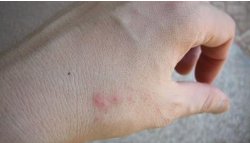Bed Bug Basics
What do they look like?
 |
Adult bed bugs are straw-colored to reddish-brown, oval-bodied, wingless insects. Before feeding, they are ¼” to 3/8” long and nearly as flat as a piece of paper. After feeding, they become bloated, dark red, and have been described as animated blood drops. Their eggs are white, slightly pear-shaped, and about 1/32” long, about the size of a pinhead. The eggs are found in clusters of between 10-50 although eggs can be found individually. Bed bugs lay eggs in their hiding places, cracks and crevices. Newly-hatched bed bugs more or less resemble the adults, only smaller.
How quickly do they multiply?
The average life-span is 10 months to a little over a year. In that time, a female may lay 200-400 eggs, depending on variables. Eggs hatch in about 10 days. The young can reach adulthood in 4-5 weeks. The females need a blood meal before laying eggs. Young bed bugs must take a blood meal before they can shed their skin and grow; they shed it 5 times before becoming an adult.
Physical signs of bed bugs
- Bites on your skin
- Blood spots on the bed
- Fecal stains (bed bug droppings are blood).
It’s a good sign but not complete confirmation - Shed skins (usually a tan color)
- Dead beg bugs
- Live bed bugs
- Visible eggs
- In areas of high infestations, they give off a distinct smell
How bad is a bed bug bite:
The common bed bug prefers to feed on humans; but will also feed on mice, rats, bats, rabbits, guinea pigs, and birds, especially chickens and swallows. Pets like dogs and cats are not a major host for bed bugs. Bed bugs feed for about 5-10 minutes at night while the host sleeps, then drop off the host and crawl to a sheltered crevice where they’ll remain for several days while digesting their meal. They tend to bite all over the body, especially on the areas that are more exposed while we sleep, such as face, neck, arms and hands; but you may not see the evidence of their feeding, because people experience a range of reactions to bites from blood-sucking insects. Some people are hardly aware, but others suffer an allergic reaction to the saliva injected while the insects fed, and may develop painful swellings. It may affect people in the same household differently.
Negative effects:
They don’t transmit disease, but scratching bites can cause secondary infections. Heavy infestations of bed bugs have been shown to cause anemia in children and the elderly. Infestation can also cause stress, mental health issues, loss of sleep and work, financial burden, poor quality of life, pesticide misuse, etc.
 |
Where are they commonly found?
Bed bugs are commonly found in the homes of travelers, the homes of people with college students, and in multiple unit dwellings (apartments, dorms, nursing homes, etc). It unfortunately has become a problem for the people who are least able to deal with it. They spread easily through buildings, and are experts at hiding. Their presence may be undetected for months, and because they can survive for about 6 months without feeding, bed bug infestations can lay dormant if the property is temporarily abandoned.
The Bed Bug’s Favorite Hiding Places: (Source, NYS Integrated Pest Management Program)
|
|
 |
Did you know that bed bugs can hide in walls, under loose pieces of wallpaper and in dirty laundry? |


